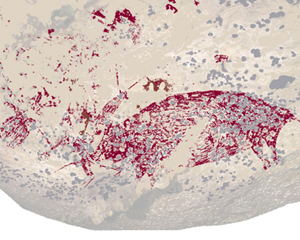Nestled among the lush mountains of the Indonesian Island of Sulawesi are caves that contain the earliest rock art ever discovered.
在印度尼西亚苏拉威西岛郁郁葱葱的群山之间的洞穴里,有迄今为止发现的最古老的岩画艺术。
Inside is a faded painting that transforms our ideas of when human creativity first emerged.
洞穴里是一幅已经褪色的岩画,它改变了我们对人类创造力首次出现的时间的观点。
And here it is, the darkened arch is a pig.
就是这个,深色的拱形是一头猪。
And if you look closely at this enhanced picture, you can see three humanlike figures, one in front and two either side.
如果你仔细观察这张增强后的照片,你可以看到三个人形,一个在前面,两个在两边。
It was painted at least 51,000 years ago.
这幅岩画至少是在51000年前绘制的。

"It's older than anything else we've got at the moment from the rest of the world.
“它比我们目前从世界其他地方获取的都要更古老。
And it raises questions about whether this art was developed especially in that region,
这引发了一个问题,即这种艺术是否是只在该地区发展起来的,
or whether this is part of a wider pattern that we don't yet have the data on to show that it was something that was much more widespread as Homo sapiens spread around the world."
还是这是否是一个我们还没有数据表明的、更广泛模式的一部分,随着智人在世界各地的传播,变得更为普遍。”
Cave paintings have been found all across the world.
在此之前,人们在世界各地都发现了洞穴壁画。
The big question is whether the ability to produce art first emerged in Africa where modern humans evolved, and spread when our species left the continent,
最大的问题是,创作艺术的能力是否首先出现在现代人类进化的非洲、并在人类离开非洲大陆时传播开来,
or did it emerge independently in different places later as there became a social need for recorded communication.
还是后来由于成为了一种对记录通信的社交需求,在不同的地方独立出现?


